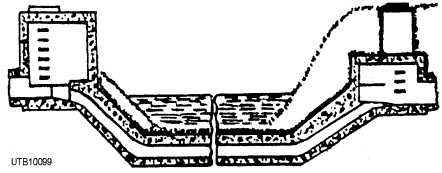to keep the pipe clear of settleable solids. The inverted siphon may have one, two, or more pipes. The amount of flow the siphon can handle should equal the amount of flow of the upstream system. A manhole should be placed at both ends of an inverted siphon, so it is easier to maintain the siphon.
Piers
Pipes can cross a small, shallow dip in the earth when they are supported by concrete piers. Piers require less maintenance than an inverted siphon and are less likely to make the wastewater become septic or cause other problems.
DESIGN
Knowledge of the design of a wastewater system can be of great help to you in constructing and maintaining the system. The amount of wastewater that can be carried depends on the size and slope of the pipe. Whether the system can carry certain types of industrial waste satisfactorily depends on the type of pipe being used. Sewer-use regulations should be enforced to keep toxic and corrosive wastes from getting into the system. The regulations may require grease traps in places where large amounts of grease will be wasted, sand traps where washracks and floor drains are built in, and pretreatment of some wastes. All sewer lines must be separated from potable water-supply lines. A cross-connection between the sewer and a potable waterline must never be allowed.
MANHOLES
Manholes let you inspect and clean sewer lines. Figure 4-34 shows the needed parts and sizes for a manhole. Manholes are required at points where the pipe changes direction and every 300 to 400 feet of piping. On large mains of 60 inches or more in diameter, the manholes are often spaced from 300 to 600 feet apart. The manhole should be built to keep the wastewater moving at about 2 feet per second, so the wastewater solids cannot settle in the pipe. A flow channel with a depth of three fourths of the diameter of the sewer pipe should be built in the manhole. The floor should slope toward the channel. The sewer lines and manhole must be well-aligned. If either the manhole or sewer line shifts, the pipe may break. A lid should fit tightly over the manhole. It must be strong enough to support traffic and heavy enough to keep someone other than maintenance workers from tampering with it. The lid should not be high enough to obstruct traffic nor low enough to let water build up over the lid.
LAYING PIPE
Knowledge of pipe laying can assist you in layout, performing maintenance, and making repairs. If the pipe is not installed properly, it can leak, break, or clog. The first step in installing a sewer pipe is digging the trench. The trench should be wide enough to permit proper installation of the pipe. Where shoring is required, ample allowance should be made in the width of the trench for proper working conditions. Where trenches are excavated to such a depth that the bottom of the trench forms a bed for the pipe, care should be exercised to provide solid and continuous bearing between joints, and bell holes should be provided at points where the pipe is joined. When excavated to such a depth that the bottom of the trench does not form a bed for the pipe, the trench should be backfilled to pipe grade. The bottom of the trench must also be sloped in the direction of flow, so sewage traveling through the pipeline laid in the trench is not restricted.
Trench Safety
Safety of the workers is a must when sewer lines are being laid. Signs, barricades, and lights should be installed and maintained in the area. The dirt from the trench should be piled at least 2 feet from the edge of the trench to keep it from falling back into the trench

Figure 4-33. - An inverted siphon.
Continue Reading